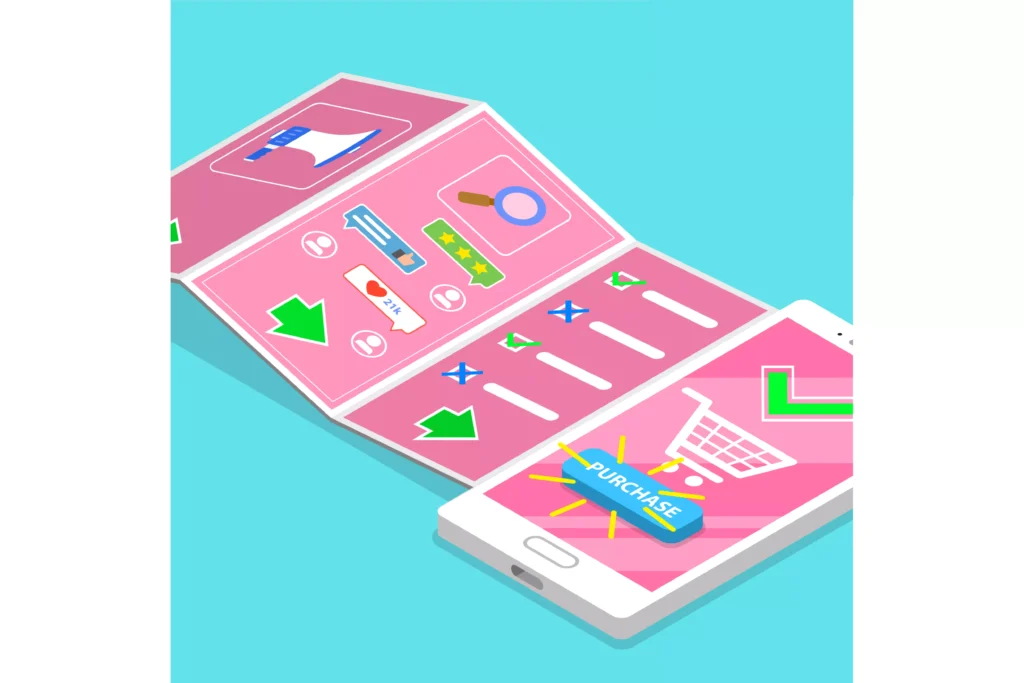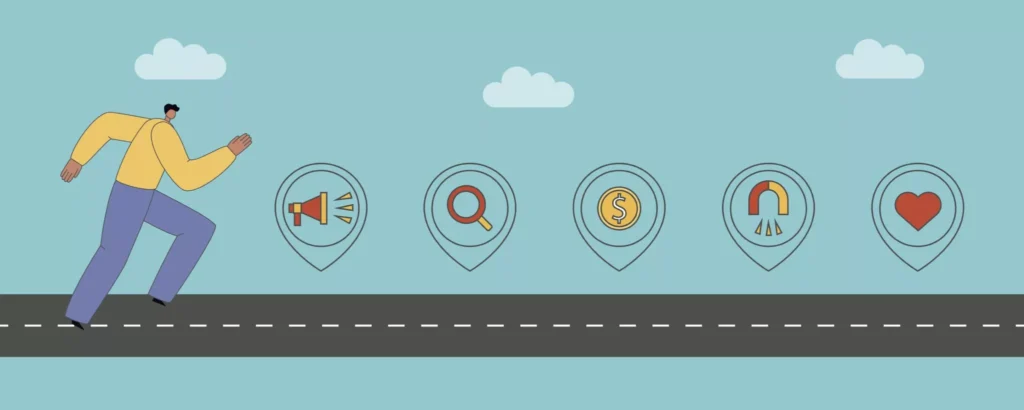Do you know that feeling where you say a word so many times that you begin questioning everything about that word? For many marketers and online retailers, it’s the word “utilize.” It’s thrown around so much and talked about all the time, and it can start to feel like one of those meaningless buzzwords we hear over and over again.
Well, we talk a lot about the post-purchase experience (PPX) here at Route. It’s what we’re all about, after all. Yet sometimes it can feel like we talk about it so much that it starts to lose its meaning. Every now and then, it’s important to take a step back, clear our minds, reset, and ask, “What even is the post-purchase experience?” to remind ourselves of what it really means.
Plus, with the critical role the post-purchase experience affects go-to metrics like repeat customer rate, customer churn, and customer lifetime value, this refresher is useful for your bottom line. Let’s step back to basics and explore the post-purchase experience.
Recap: Stages of the Customer Journey

The customer journey can be broken down into five essential stages: reach, acquire, nurture, retention, and advocacy. They’re all essential to the overall experience of the customer’s time spent with your brand and each stage is critical in determining whether or not they’ll become a loyal customer. The first stage, reach, is all about getting in front of your target market. You’re developing awareness for your product and your brand. Your marketing materials and content drive traffic to your shoppable channels.
Next, customers (hopefully 🤞) hit the acquisition stage. You don’t have a business if none of the consumers you reach turn into paying customers.
This is the time when shoppers convert and make their first purchase. During this stage, brands can start collecting real data that informs them about what type of person is buying. Third, there’s the nurture stage where your brand keeps in contact with past customers. You don’t want to forget about them! Not only is it easier to sell to existing customers than it is to new ones, existing customers are 50% more likely to try a new product and spend 31% more than a new customer. While you keep in contact with these customers, you can use back-end analytics to predict what they’re likely interested in and use that to send personalized communications to them, like tailored product recommendations or coupons for the things they buy most often.
In the retention stage, your customers are coming back for more (and hopefully spending more). Performing customer feedback surveys can uncover the top reasons that customers love your brand (or why some may be leaving). This is the part where customer loyalty can be earned or soured, so it’s important for online sellers to not let a good customer relationship slip through the cracks.
In the final stage, customers become advocates of your brand. They’ve come back to purchase products multiple times and now, ideally, they will recommend you to their friends and family. True satisfaction with your brand leads to micro brand advocates who leave good reviews, spread the word far and wide, and will dedicate their lives to your store stay loyal to your brand for the long haul.

When Does the Post-purchase Experience Happen?
Believe it or not (and we have no idea why you wouldn’t believe it), every phase beyond the acquisition phase is a part of the PPX. Take a look at most of the SaaS businesses out there; many are focused on the pre-purchase stages of the customer journey. So much of our time and resources are spent on reach and acquisition — and they’re obviously important! But it’s important not to abandon your customers after they’ve clicked the Buy button.
This tactic makes even more sense when we remember that most revenue comes from the PPX stages. Given that returning customers spend more money with little-to-no reacquisition costs, brands must remember to make the PPX experience great enough to get customers coming back.
Counting every step beyond checkout as part of the PPX means that post-purchase includes the nurture, retention, and advocacy phases. While this may seem like strategies to nail each of these phases means sending a couple emails or tossing up a few ads, there’s more to the post-purchase experience than meets the eye.
Your customers are impacted by far more than a retargeting ad or personalized email. Once someone invests enough clout in your brand to finally pull the trigger and make a purchase, they’ve put a lot of trust in your store. And while an automated cross-selling email may be a nice touch point, it doesn’t do much when it comes to assuaging pre-parcel anxiety, further building trust, and treating the customer with care and support.
Tracking, shipping, transparency, engagement post-checkout, and basically everything that happens between purchases one and two, helps determine if the customer comes back through your store or runs toward the competition.
Put the Post-purchase Experience on a Pedestal
To keep your customers coming back and build coveted, long-lasting loyalty, the experiences they have after they’ve purchased from your brand must differentiate you from the competition. In the ecommerce world, where pretty much any product imaginable can be created and replicated, experience is often the deciding difference between brands.
A bad or neglected PPX can lead to lost customers, lost revenue, and a bad overall customer experience that can bleed your loyalty and brand’s reputation. With the knowledge in hand that the post-purchase experience has an immense impact on ecommerce’s bottom line, and it’s comprised of touchpoints between and beyond emailed nurture sequences and targeted social ads, now’s the time to think about the parts of the PPX you may be overlooking.
Consider these post-purchase strategies that differentiate your brand and deliver a better customer experience:
- Real-time Package Tracking
Make your tracking process streamlined and engaging. Don’t make your customers sift through their inboxes to find tracking numbers and carry the workload of simply knowing where their stuff is. Unclear or clunky package tracking leads to a bogged down support team answering low-value WISMO calls, diminished trust, and an anxious overall experience.
Making package tracking simple, transparent, and readily available instills trust and will offload the majority of your team’s support calls, freeing you up to innovate your brand. Post-purchase platforms like Route simplify package tracking and strengthen engagement between brand and shopper until the package is delivered.
When shoppers use the Route app, they have a bird’s-eye view of every online purchase they make and can see them on a single map showing package locations, routes, and ETAs. - Stress-free Shipping
While it’s not feasible for every single ecommerce brand, it’s a good idea these days to offer free shipping. Amazon has created a universal standard surrounding free, fast shipping, and it’s a benefit some shoppers consider a must-have. Thankfully, there are many ways to offer free shipping without busting your bottom line, making it a possibility for even the smallest of online brands
- Crystal Clear Transparency
Something that leaves a sour taste in the customer’s mouth is a foggy policy. When they’re left scrambling for solutions about how to return a package, how to file a claim if their stuff is incorrect or damaged, or where to contact support, stress and mistrust settles in—fast.
Be up front with your return policies and make any exchanges or refunds as easy as possible. Customers want to be able to reach your team to talk about purchase loss, damage, or theft, and they want to be able to do it in as few clicks as possible. The more transparent your brand can be during the PPX, the more trust you’ll instill customers. If they feel cared for and supported no matter what comes up, they’ll carry that trust forward into future purchases. - Engage and Communicate
Most of all, remember that your customers are people just like you, and treating them with care and compassion goes a long way. Genuine engagement and communication shows customers that you’re committed to their experience and their satisfaction—plus, we all love simply being acknowledged from time to time.
Use data that you’ve collected from every available channel to learn more about your customers. This means dig deeper into their unique shopper journey, explore the pages they visit, the emails they open, the devices they use, then use that data for creating a more thoughtful and delightful experience. The more you know about your customers, the better and more personalized engagements you can offer throughout the PPX.
An Optimized Post-purchase Experience Is Priceless
A good PPX leads to happier customers, higher retention, better reviews, and more positive word of mouth for your brand. Make sure that your brand is doing everything in your power to offer the best PPX on the market and drive the most customers possible through the entire customer lifecycle, from the moment they meet your brand all the way until they’ve become self-propelled advocates for your brand and your products.
Understanding the post-purchase experience—really understanding it and not just limiting it to a single post-purchase “thank you” email—could be the difference between standing out or closing up. Expand your idea of what the PPX entails and finally rip open the untapped potential of post-purchase strategies. Who knows, you might just be building the next industry-shifting Amazon.